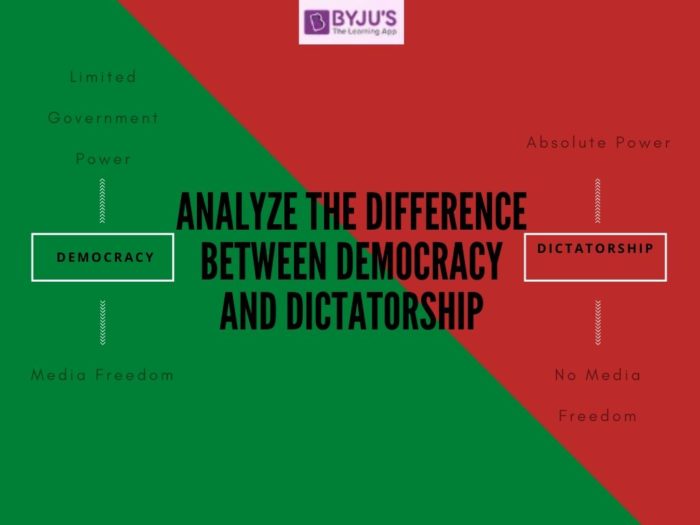Democracy and Dictatorship are diverging systems of government forever at odds with each other.
Democracy is a system of government which is chosen by the entire population or other eligible members of the state through elected representatives.
A dictatorship is a form of government where a single individual or group of people wield power without any limitations to constitutional authority.

This article will further highlight the differences between democracy and dictatorship within the context of the IAS Exam
Aspirants can find more Difference Between Articles, by visiting the linked page
The difference between Democracy and Dictatorship is given in the table below:
Differences between Democracy and Dictatorship
| Democracy |
Dictatorship |
| The head of the country in a democratic government is the one who gets the most support in the form of votes in a general election. | One individual is the sole authority of the country with no institution to keep its power in check |
| Political control in a country is provided through free and fair elections, with two or more political parties being involved. | In a dictatorship no elections take place or they are heavily regulated by restricting the number of political parties and limiting gatherings and associations |
| The media in a democratic form of government is known as the fourth pillar of democracy as they watch the government’s every move and criticise it should any misstep be taken. | The media is the mouthpiece of a dictatorial government. Regardless of what a dictator does, the media will only show what needs to be shown to the masses so that a cult of personality is always maintained. |
| In a democracy, the fundamental rights of the citizen are protected by the constitution. Citizens have the right to join political parties and other organizations. | In a dictatorship, little importance is given to fundamental rights, with the populace being generally subjected to constant policing, monitoring and brutality. |
| The earliest forms of democracy appeared in Ancient Greece. It is generally accepted that the Athenians established what is held as the first democracy in 508–507 BC. The democracy was rudimentary in the sense that only free-males of Athens could cast their votes but not women and slaves | Lucius Cornelius Sulla Felix and Gaius Julius Ceaser of Ancient Rome can be considered as the first dictators. |
Democracy and Dictatorship are terms which are featured in the Polity segment of the UPSC Exams. Aspirants can find study materials related to this segment with the links given below:
- Indian Polity Notes for UPSC
- Polity Syllabus and Strategy for UPSC
- Important Books for Political Science Optionals
- Constitution of India
Difference Between Democracy and Dictatorship – Download PDF Here
Frequently Asked Questions about Democracy and Dictatorship
What are the 2 types of democracy?
Who is an example of a dictator?
Candidates can find the general pattern of the UPSC Exams by visiting the UPSC Syllabus page. For more articles and exam-related preparation materials, refer to the links given in the table below:
Related Links
Comments